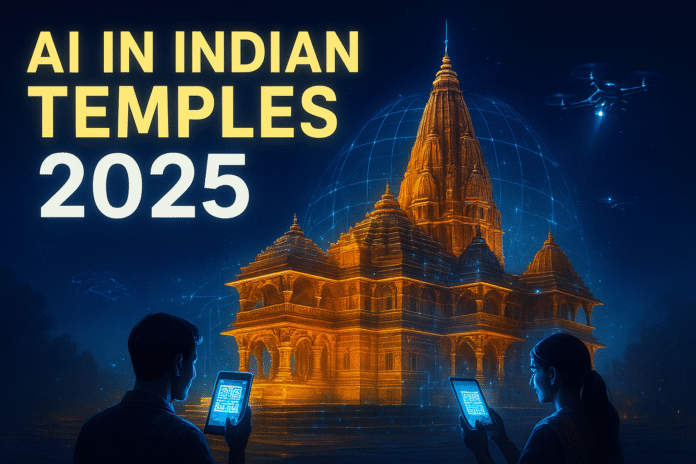Smart Temples of India has always been called the land of devotion. From the early morning sound of conch shells to the rhythmic chanting of mantras in the evening, spirituality is deeply woven into the everyday life of this country. Temples, in particular, are not just stone structures here — they are living ecosystems. They host rituals, festivals, community kitchens, and they carry forward thousands of years of cultural memory.
But something fascinating is happening in 2025. The same temples that were once seen as symbols of timeless tradition are now adopting some of the most modern technologies in the world. Artificial Intelligence, drones, Virtual Reality, QR codes, and digital payment systems are slowly finding a permanent place inside India’s spiritual spaces. What we are witnessing is not a clash between tradition and modernity. Instead, it’s a merger — where faith is not being replaced, but reimagined for a new generation. Welcome to the world of Smart Temples of India.
Why Do Smart Temples of India Even Need Technology?
If you ask a traditional devotee, they might wonder: Why bring technology into temples? Aren’t temples supposed to remain untouched, pure, and ancient. It’s a valid question. But the reality is that temples in modern Smart Temples of India face challenges that are bigger than ever:
- Crowd Management: Some temples attract lakhs of visitors in a single day. Festivals often bring in human seas that are impossible to manage without smart planning.
- Donations & Transparency: With millions in cash flowing daily, accountability is always under question. Technology offers a way to handle funds without suspicion.
- Accessibility: Not every devotee can travel. Senior citizens, people with disabilities, and Indians living abroad often feel disconnected from their places of worship.
- Security: Temples have always been vulnerable to theft, accidents, and sometimes even violence. Monitoring huge gatherings is no small task.
- Cultural Preservation: Ancient manuscripts, chants, and rituals risk being lost forever if not carefully documented.
This is where Artificial Intelligence and digital tools step in. They don’t replace the sacred. Instead, they ensure that sacredness survives in the modern world.
Ayodhya Ram Mandir: Setting the Benchmark
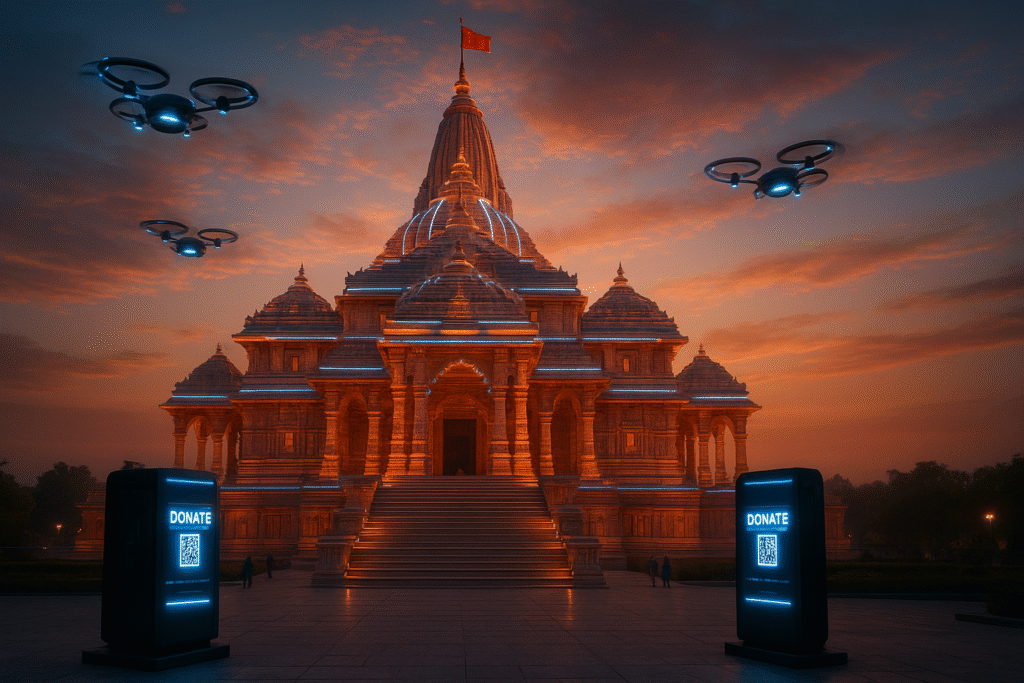
If there is one temple that symbolizes India’s spiritual rebirth, it is the newly built Ram Mandir in Ayodhya. With lakhs of devotees visiting every month, Ayodhya faced a unique challenge right after its grand inauguration — how to handle such a massive flow of people.
Here, Artificial Intelligence is proving to be a blessing:
- AI-Powered Cameras: Cameras installed across the complex study crowd density in real time. They can predict where congestion might occur and alert authorities instantly.
- Drone Surveillance: Drones hover above the temple on festival days, feeding live images to control rooms.
- Digital Donations: Instead of putting loose change into a hundi, devotees now simply scan a QR code. The money goes directly into the temple trust’s bank account — transparent and traceable.
- Smart Temple Apps: Devotees can check live darshan timings, book entry slots, and even receive instant chatbot replies about pooja schedules.
Ayodhya shows that faith doesn’t have to fear modernity. When handled correctly, technology actually protects the sanctity of the temple.
Tirupati Balaji: The World’s Smartest Queue
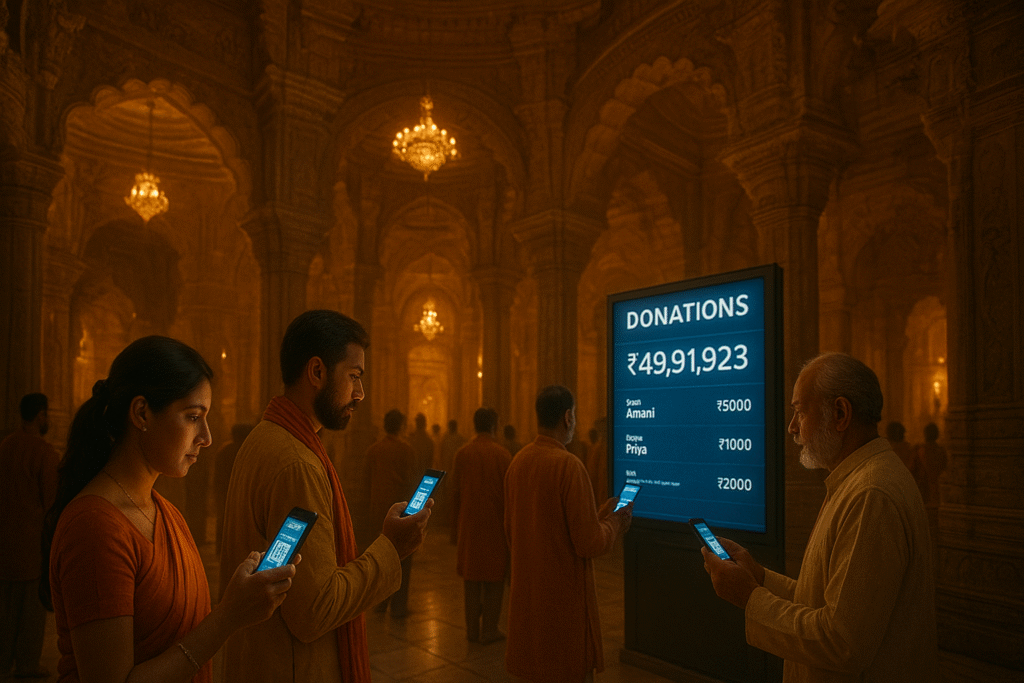
If Ayodhya is about cultural pride, Tirumala Tirupati Balaji Temple is about sheer scale. With nearly one lakh visitors on a normal day, Tirupati has been experimenting with technology long before Smart Temples of India became a buzzword.
Here’s how AI and automation keep order in this temple city:
- AI Queue Prediction: Cameras and motion sensors calculate how long each devotee will take to reach the sanctum. This reduces waiting times and avoids chaos.
- Facial Recognition: VIPs, elderly devotees, and differently-abled individuals get their passes verified instantly through face recognition technology.
- Slot Booking & Online Darshan: Instead of standing in a line for hours, devotees can book their darshan weeks in advance through the temple’s website.
- AI in Food Distribution: Tirupati serves free meals to thousands daily. AI systems now analyze crowd patterns and guide the kitchens on how much food to prepare.
The result? What once used to be a suffocating wait is now a relatively smooth spiritual experience.
Siddhivinayak Temple: Global Devotion at Your Fingertips
Mumbai’s Shree Siddhivinayak Temple has always been special. It’s where film stars, businessmen, politicians, and everyday devotees come to seek blessings. But in 2025, Siddhivinayak has turned into a global spiritual brand.
- Virtual Aartis: Using 4K cameras, Siddhivinayak streams live aartis worldwide. A devotee sitting in New Jersey can join the evening prayers in Mumbai with just a click.
- Global Donations: NRIs no longer worry about sending money through relatives. Digital payment platforms now accept multi-currency donations directly.
- AI-Powered Personalization: The temple app sends birthday blessings, reminders of special poojas, and even suggestions for rituals based on past preferences.
Siddhivinayak demonstrates how a temple can expand its reach from a local shrine to a global spiritual hub.
Key Technologies Behind
Let’s break down the backbone of this transformation:
1. Artificial Intelligence
- Predicts peak hours and allocates security staff accordingly.
- Spots suspicious activity in crowded areas.
- Personalizes a devotee’s journey by suggesting prayers or bhajans.
2. Digital Payments (QR Codes & UPI)
- No more long queues at donation counters.
- Temples receive direct bank transfers with receipts.
- Devotees abroad can contribute instantly.
3. Virtual & Augmented Reality
- VR Darshan lets devotees experience temple interiors in 360° from their homes.
- AR glasses for temple tourism narrate mythological stories as people walk around.
4. Smart Surveillance (Drones & Sensors)
- Keeps an eye on massive gatherings like Kumbh Mela.
- Reduces human error in monitoring.
5. Digital Archives & Preservation
- Ancient chants are being recorded in high quality.
- AI-based voice tech can now recreate rare Vedic recitations.
Benefits for Devotees
- Less Waiting: AI drastically reduces queue times.
- Inclusivity: The elderly and disabled can access temples with special support.
- Global Access: Indians abroad can attend rituals virtually.
- Peace of Mind: Digital payments ensure transparency in how donations are used.
Benefits for Temples
- Efficient Operations: Managing food, crowds, and security becomes smoother.
- Financial Growth: Easier payments mean higher donations.
- Preserving Culture: Digitization keeps traditions alive.
- Eco-Friendly Practices: Less paper, less cash, and greener processes.
Challenges Temples Face
- Digital Divide: Rural devotees still prefer traditional ways.
- Cybersecurity: Donation data and financial details need strong protection.
- Cost of Adoption: Smaller temples cannot afford high-tech upgrades.
- Balancing Faith and Modernity: Too much tech can make some devotees uncomfortable.
The Future of Smart Temples (Beyond 2025)
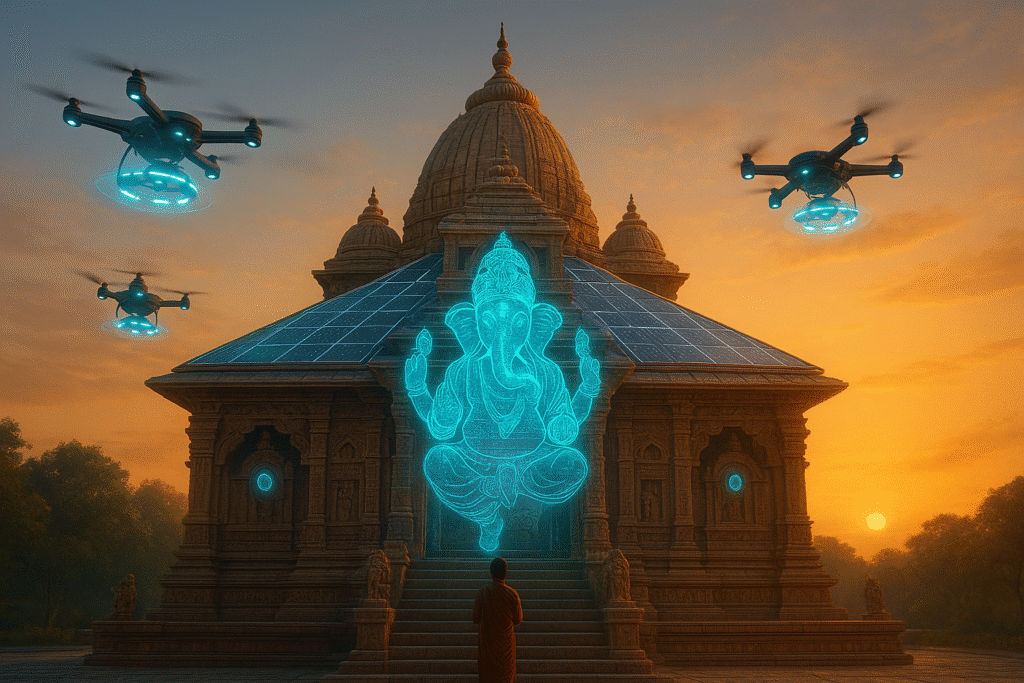
What’s coming next?
- AI Priests: Chanting systems powered by AI to guide rituals.
- Blockchain Donations: Ultra-transparent ledgers of every rupee donated.
- Robots in Temples: Assisting with prasad distribution and guiding visitors.
- AR Storytelling: Mythological stories playing around you in augmented reality as you walk through temple corridors.
- Global Virtual Pooja Services: Sitting in London but booking a personalized pooja in Varanasi with live streaming.
The temple of the future won’t be bound by geography. Spirituality will travel across borders, carried by technology.
Where Faith Meets the Future
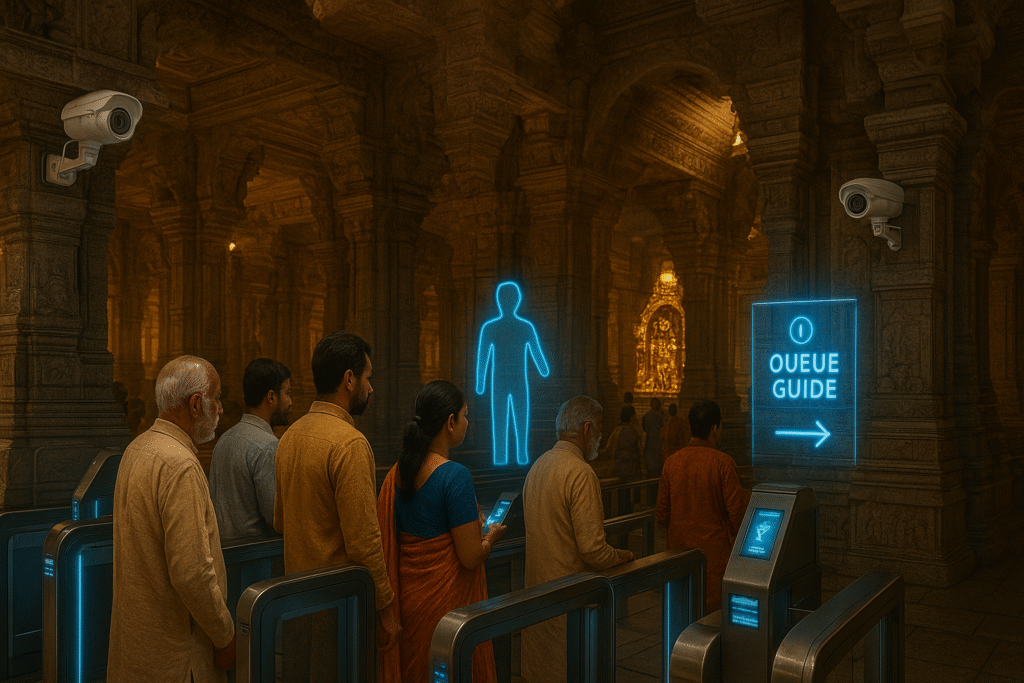
Smart Temples of India are stepping into a new chapter. From Ayodhya’s AI-driven crowd control to Siddhivinayak’s worldwide live aartis, the transformation is undeniable. What’s remarkable is that the essence of worship hasn’t been lost. Bells still ring. Priests still chant. Flowers and incense still carry fragrance in the sanctum. Technology is not replacing devotion; it is simply removing the barriers that once made it difficult. In a way, it is making spirituality more democratic — accessible to everyone, everywhere. India has always been known for keeping tradition alive through centuries of change. Now, it is proving once again that faith can walk hand in hand with the future.
“Faith is eternal, technology is a tool — together they are building India’s Smart Temples of the future.”


